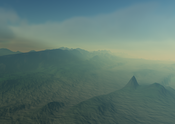Information
- Publication Type: Bachelor Thesis
- Workgroup(s)/Project(s):
- Date: February 2020
- Date (Start): June 2019
- Date (End): 24. February 2020
- Matrikelnummer: 01633397
- First Supervisor:
- Keywords: rendering, real-time, GPU, terrain
Abstract
Planetary rendering solutions often suffer from artifacts or low performance when rendering very big terrains with high details. In this thesis, we present a method that targets real-time applications and therefore aims to achieve high performance. The method can be applied with an arbitrary amount of detail, which enables stable performance under runtime or hardware restriction. In contrast to existing methods, like quadtrees and clipmaps, our method avoids artifacts, such as popping or swimming, as much as possible. The method submits coarse, rectangular regions of cells around the viewer to NVidia’s new geometry pipeline that was introduced with their Turing Architecture. Due to the capabilities of the new pipeline, we can make efficient level-of-detail decisions on the graphics processing unit (GPU) and produce work to create circular regions from the rectangular ones. These circular regions provide uniform terrain resolution for the viewer in all directions, while maintaining low rendering times.Additional Files and Images
Weblinks
No further information available.BibTeX
@bachelorsthesis{rumpelnik_martin_2020_PRM,
title = "Planetary Rendering with Mesh Shaders",
author = "Martin Rumpelnik",
year = "2020",
abstract = "Planetary rendering solutions often suffer from artifacts or
low performance when rendering very big terrains with high
details. In this thesis, we present a method that targets
real-time applications and therefore aims to achieve high
performance. The method can be applied with an arbitrary
amount of detail, which enables stable performance under
runtime or hardware restriction. In contrast to existing
methods, like quadtrees and clipmaps, our method avoids
artifacts, such as popping or swimming, as much as possible.
The method submits coarse, rectangular regions of cells
around the viewer to NVidia’s new geometry pipeline that
was introduced with their Turing Architecture. Due to the
capabilities of the new pipeline, we can make efficient
level-of-detail decisions on the graphics processing unit
(GPU) and produce work to create circular regions from the
rectangular ones. These circular regions provide uniform
terrain resolution for the viewer in all directions, while
maintaining low rendering times.",
month = feb,
address = "Favoritenstrasse 9-11/E193-02, A-1040 Vienna, Austria",
school = "Research Unit of Computer Graphics, Institute of Visual
Computing and Human-Centered Technology, Faculty of
Informatics, TU Wien ",
keywords = "rendering, real-time, GPU, terrain",
URL = "https://www.cg.tuwien.ac.at/research/publications/2020/rumpelnik_martin_2020_PRM/",
}

 Thesis
Thesis


